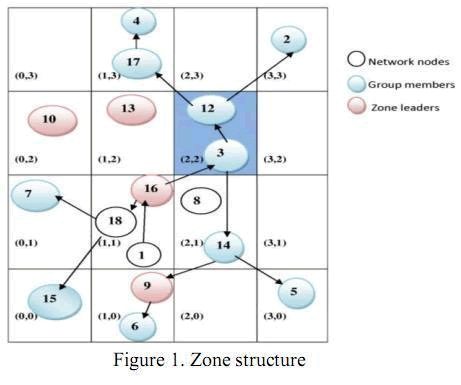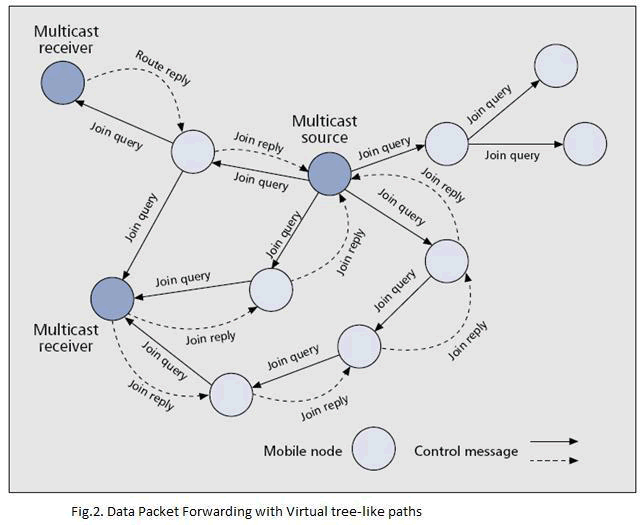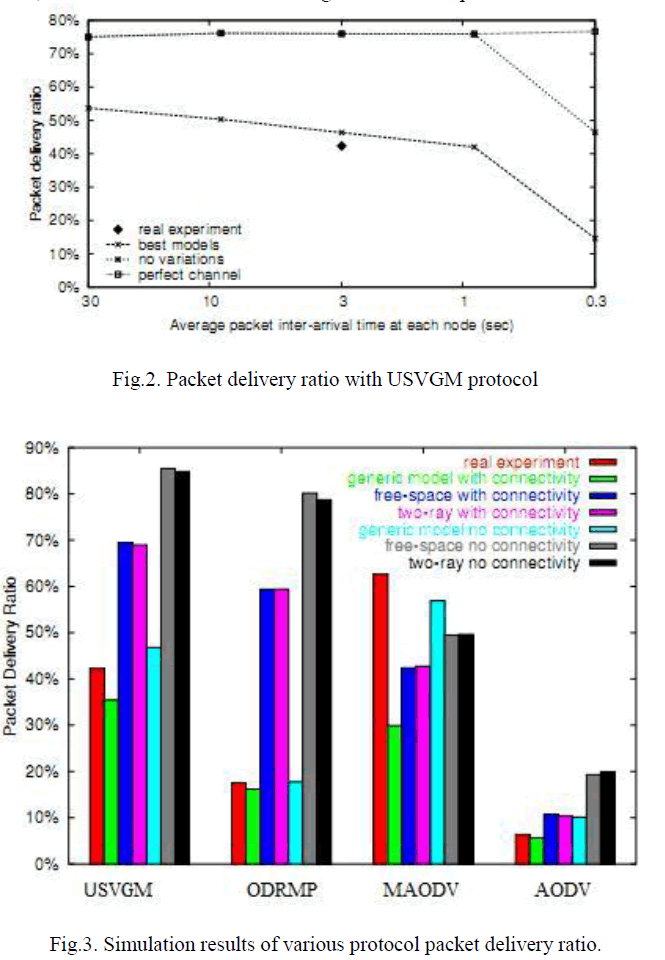ISSN ONLINE(2320-9801) PRINT (2320-9798)
ISSN ONLINE(2320-9801) PRINT (2320-9798)
B.V.V.S. Prasad (Ph.D)1, Dr. G. Manoj Someswar2
|
| Related article at Pubmed, Scholar Google |
Visit for more related articles at International Journal of Innovative Research in Computer and Communication Engineering
Now a day’s Mobile ad-hoc networks became a popular subject for research due to its wide utilization in different areas, and various studies have been made to increase the performance of ad hoc networks and support more advanced mobile computing and applications. Multicasting is a useful operation that facilitates group communications in MANETs. There are some problems of the existed mobile computing applications are multicast group membership management, zone construction and efficient forwarding of packets to all the group members over the dynamic network topology for a large group size or network size. This paper concentrated specifically, on efficient packet forwarding through a virtual-zone-based structure, and the location service for group members is integrated with the membership management. Both the control messages and data packets are forwarded along efficient tree-like paths, but there is no need to explicitly create and actively maintain a tree structure. The stateless virtual-tree-based structures significantly reduce the tree management overhead, support more efficient transmissions, and make the transmissions much more robust to dynamics. By upgrading the USVGM protocol with virtual-zone-based structure and tree-like paths we achieved higher performance and reliable and scalable data packet forwarding. Our simulation results demonstrate that Upgraded SVGM (USVGM) has high packet delivery ratio, low control overhead and multicast group joining delay under all test scenarios, and is scalable to both group size and network size.
Keywords |
| USVGM, LAM, MZRP, LGT, LGS |
INTRODUCTION |
| MANET is a collection of wireless nodes that can dynamically be set up any where and anytime without using any preexisting network infrastructure. It is an autonomous system in which mobile hosts connected by wireless links are free to move randomly and often act as routers at the same time. The traffic types in ad hoc networks are quite different from those in an infrastructure wireless network. Due to its popularity and wide advantages MANET are applied to different applications including battlefield communications, emergency relief scenarios, law enforcement, public meeting, virtual class room and other security- sensitive computing environments. Multicasting is a powerful scenario in MANET’s environment. The design of the multicast scheme in MANET is more complex because of the dynamic change in the network topology and the limited bandwidth availability. Previous researches designed some ad hoc network routing protocols LAM [3], MZRP [5] and ODMRP[6]are to enable the membership management and transport of data packets from one point to another. But all of these protocols can have their own inherent limitations due the nodes dynamism, increasing group members and maintaining the complex group structure. Another main challenge in MANET is to design t he robust security solutions that can protect MANET from various routing attacks. |
| In order to address the issues in multicasting over MANETs, we propose a Upgraded Scalable Virtual structures based Geographic Multicasting(USVGM) Protocol, which can extent to a large group size and large network size and this protocol will provide efficient multicast packet transmissions in a dynamic mobile ad hoc network environment. In USVGM protocol, there is no need of maintaining state information at each network node for robust and scalable packet transmission in dynamic environment. We introduce several virtual architectures for more robust and scalable membership management and packet forwarding in the presence of high network dynamics due to unstable wireless channels and frequent node movements. Both the data packets and control messages will be transmitted along efficient tree-like paths, however, different from other tree-based protocols, there is no need to explicitly create and maintain a tree structure. A virtual – tree structure can be formed during packet forwarding with the guidance of no depositions. Furthermore, USVGMP makes use of position information (GPS) to support reliable packet forwarding. The main intension of USVGMP is to improve the performance of the network and also USVGMP achieves a significantly higher data packet delivery ratio. |
II. LITERATURE WORK |
| In order to support more reliable and scalable communications, recently several conventional location-based multicasting protocols are introduced in MANET. In this section we present and classify existing multicast routing protocol for MANETs. A brief overview of a few existing multicast protocols that are relevant to our work is provided. Conventional topology-based multi cast protocols include tree-based protocols (e.g.,[3],[5]])and mesh-based protocols (e.g.,[4],[6]). Tree- based protocols construct a tree structures form more efficient forwarding of packets to all the group members. Mesh-based protocols expand a multicast tree with additional paths that can be used to forward multicast data packets when some of the links break. The tree-based protocols construct a tree structure for more efficient multicast packet delivery and the tree structure is known for its efficiency in utilizing network resources. However, it is very difficult to maintain the tree structure in mobile ad hoc networks, and the tree connection is easy to break and the transmission is not reliable. |
| The mesh-based protocols are proposed to enhance the robustness with the use of redundant paths between the source and the set of multicast group members, which incurs a higher forwarding overhead. There is a big challenge to support reliable and scalable multicast in a MANET with the set topology-based schemes, as it is difficult to manage group membership, find and maintain multicast paths with constant network topology changes. A topology- based multicast protocol generally has the following three inherent components that make them difficult to scale: Group membership management, Creation and maintenance of a tree or mesh-based multicast structure, Multicast packet forwarding. Besides the three components included in conventional topology-based multicast protocols, a geographic multicast protocol also requires a location service to obtain the positions of the members. The geographic multicast protocols presented in[7] and [2] need to put the information of the entire tree. The Position Based Multicast Protocol [8] which uses the geographic position of the nodes to make forwarding decisions. PBM neither requires the maintenance of a distribution structure nor resorts to flooding. The Location-Guided Tree [4] is applicable for small communication group. In this protocol an upper overlay packet delivery tree is created on top of the underlying uni cast protocol. LGT requires each group member to know the locations of all other members, and proposes two overlay multicast trees: ab and width – minimizing LGS tree and a delay- minimizing LGK tree. |
III. USVGM PROTOCOL |
A. Overview of USVGM Protocol |
| USVGM supports scalable and reliable membership management and multicast packet forwarding through a two-tier virtual zone- based structure. First the entire network region is divided into zones based on the GPS information. Each zone will act as a separate environment to maintain the mobile nodes structure. These zones are arranged at lower level of two tier architecture and managed by the zone leader. Zone Leader maintains the local group membership (node position, group id) efficiently. At the upper tier, the leaders of the member zones (zone which contain the group members) report the zone membership to the sources directly a long a virtual reverse-tree-based structure. If a leader is unaware of the position or addresses of the source, it could obtain the information from the Source Home. With the knowledge of the member zones, a source forwards data packets to the zones that have group members along the virtual tree rooted at the source. After the packets arrive at a member zone, the leader of the zone will further forward the packets to the local members in the zone along the virtual tree rooted at the leader. For efficient and reliable management and transmissions, location information will be integrated with the design and used to guide the zone construction, group membership management, multicast tree construction and maintenance, and packet forwarding. The zone –based tree is shared for all the multicast sources of a group. |
B. Virtual Zone Construction and Leader election |
| In USVGM first we can divide the entire network region into the virtual zones based on the network reference point. The constructed zones are shape independent and managed by the zone leaders. These virtual zones are used as references for the nodes to find their zone positions in the network region. The zone is set relative to a virtual origin located at (xo,yo)which is set at the network initialization stage a some of the network parameters. The length of a side of the zone square is defined as zone size. Each zone is identified by a zone ID (zID). These zone IDs are useful to locate a zone in network region and to forward the data packets to the destination points (multicast member nodes). |
| To maintain the zone and its contained group members information we need a node that is called as a zone leader (ZLdr).This zone leader is any member node to maintain the other members information of that zone. At lower level of out protocol zone leader will maintain the communication with source home of upper layer. In this protocol we are not maintaining the neighbor node information at each node due to its maintenance overhead problem. Each node is equipped with the node GroupId, zId, ZLdr info and its current location information through the in-built GPS information system. When a node n1 wants to join to a zone z1, it will enquires the neighbor about the zone leader. Neighbor node will gives the ZLdr information to node n1.Now at a certain refresh interval time n1 will forwards the joining request along with GroupID and the |
 |
| positional information to ZLdr to maintain the n1 information at leader. If there is no ZLdr found in that zone then n1 as itself announced as a ZLdr and spread that information to all other nodes in that zone at next interval time. This will overcome the empty-zone problem which is a problem in previous works. ZLdr contained information can be updated at each refresh interval time to maintain the node joining and leavings information up-to-date. |
Efficient Membership management at two layers |
| In USVGM protocol group membership is managed at two tiers. At first level the local group members are efficiently managed by the zone leader. USVGM takes advantage of the virtual-zone-based structure to efficiently track the group membership and member positions. In order to maintain the nodes information at zone level we can use the multicast group (G), Data Source(S) and group member variable (M). |
| a) Zone level membership management: The group membership is first aggregated in the local zone and managed by the zone leader. All the mobile nodes can have the mobility nature, so they can frequently change from one location to another. Due to this reason maintaining the membership became complex for previous protocols. In USVGM the nodes when they have to join to or leave from a group they will send a message to the zone leader. All the member nodes will sends its Group id, position, flag information to zone leader at each refresh interval time to maintain the updated nodes data and to handle the dynamic changes in group membership. For example if a node N1 has to move from zone Z1 to Z2 first it will sends a leave request to the zone leader of Z1 and a join request to zone leader of Z2at a certain refresh time. Then it initiates the changing from zone Z1 to zone Z2. Suppose the zone leader is unable to receive the leave request it will never create the problem, because A member record will be automatically removed by the zone leader if not refreshed within 2 refresh intervals. |
b) Higher(network) level Membership management |
| At higher level of this protocol layer all the member zones information is used by sources to initiate the multicast packets to the destination nodes. Zone leader is the responsible node to track all the member nodes information in that zone and sending that information to sources. When the source has to transfer the multicast data then it will consider all the zones and tracks the ID’s of the member zones that have multicast group members. When a zone changes from a member zone to a non-member zone of G or vice versa, the zone leader sends a REPORT message immediately to Source to notify the change. Zone leader obtains the source information from Source Home, which is one of the zone in network region to maintain all the sources information. Like zone members, Zone leader sends the zone members information to the source at each refresh interval time. This process remains the zone information at source up-to-date. In the case that S is the source of more than one multicast group, instead of sending a REPORT to S for each group, the leader sends one REPORT carrying all corresponding group IDs. If any zone leader is fail to send the zone information to source after 2 continuous intervals the zone information is removed by the zone leader. This process will overcome the empty zone and zone checking problems. |
Scalable Packet forwarding through virtual tree like paths: |
| A source needs to send the multicast packets reliably to the group members. With the membership management, the member zones are recorded by source S, while the local group members and their positions are recorded by the zone leaders. Multicast packets will be sent along a virtual distribution tree from the source to the member zones, and then along a virtual distribution tree from the zone leader to the group members. A virtual distribution tree is formulated during transmission time and guided by the destination positions. The multicast packets are first delivered by S to member zones towards their zone centers. S sends a multicast packet to all the member zones, and to the member nodes in its own zone through the zone leader. |
 |
| In our protocol, only zLdrs maintain the multicast table, and the member zones normally cannot be reached within one hop from the source. When a node N has a multicast packet to forward to alist of destinations (D1; D2; D3; :), it decides the next hop node towards each destination using the geographic forwarding strategy. After deciding the next hop nodes, N inserts the list of next hop nodes. And the destinations associated with each next hop node in the packet header. An example list is (N1: D1; D3; N2: D2; :), where N1 is the next hop node for the destinations D1 and D3, and N2isthe next hopnodeforD2.ThenNbroadcaststhepacket promiscuously. Upon receiving the packet, a neighbor node will keep the packet if it is one of the next hop nodes or destinations, and drop the packet otherwise. When the node is associated with some down stream destinations, it will continue forwarding packets similarly as done by node N. For example, in fig. 1, after node 3 receives the packet from zone (1, 1) it will forward the packet to down stream zones (2.1),(1,3)and(3,3).It determines the next hop node for destination and insert the list (12:(1,3),(3,3);14:(2,1)) in the packet header. After broad casting the packet its one-hop node 12, 14 and node8 will drop this packet, while node 12 and 14 will continue forwarding. Node 12 replaces the list carried in the packet header with (17:(1,3);2:(3,3)) and broadcast the packet. Node 14 finds group information from its multicast table and broadcast the packet with a header (9: (1, 0); 5: (3, 0)).Only one copy needs to be sent when packets for different destinations share the same next hop node. Thus thepackets are forwarded along a tree-like path without the needof building and maintaining the tree in advance. For robust transmissions, geographic uni cast is used in packet forwarding. The packets can also be sent through broadcast to further reduce forwarding bandwidth, at the cost of reliability. |
IV. PERFORMANCE EVALUATION |
| In this section, we study the performance of SVGP by simulations. We are mainly interested in the protocol’s scalability and efficiency in a dynamic environment. We implemented the SVGP protocol using NS2 Simulation. A multicast source broadcasts Join-Query messages to the entire network periodically. We focus on the packet delivery ration and normalized control overhead to present the effectiveness of a protocol, on the average hop count and the uni casting delay to prove the virtual tree paths cost value, and on the normalized forwarding overhead to express the data traffic load on the network. |
 |
| We first examine the message delivery ratio. Figure 2 shows the message delivery ratio from source to each node that runs with USVGM protocol propagation model. Then later we concentrated on the packet delivery ratio results between the various protocols like AODV, MAODV, ODRMP, USVGM. The above results in fig. 3.shows that at average USVGM protocol can have the best packet delivery ratio among all other previous protocols and it is easy implement, maintain and less overhead problem. |
V. CONCLUSION |
| In this paper, we propose an efficient and scalable geographic multicast protocol, USVGM, for MANET. The scalability of USVGM is achieved through a two-tier virtual-zone-based structure, which takes advantage of the geometric information to greatly simplify the zone management and packet forwarding. A zone-based bidirectional multicast treeis built at the upper tier for more efficient multicast membership management and data delivery, while the intra zone management is performed at the lower tier to realize the local membership management. The position information is used in the protocol to guide the zone structure building, multicast tree construction, maintenance, and multicast packet forwarding. Compared to conventional topology based multicast protocols, the use of location information in EGMP significantly reduces the tree construction and maintenance over head, and enables quicker tree structure adaptation to the network topology change. |
References |
|